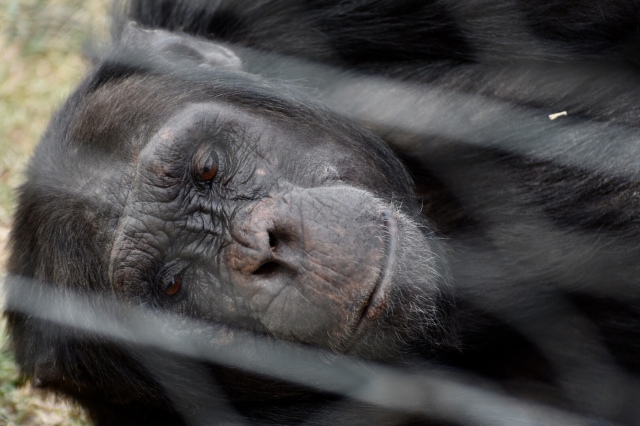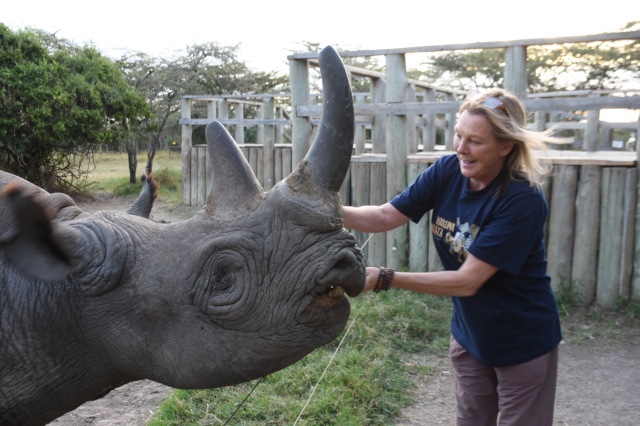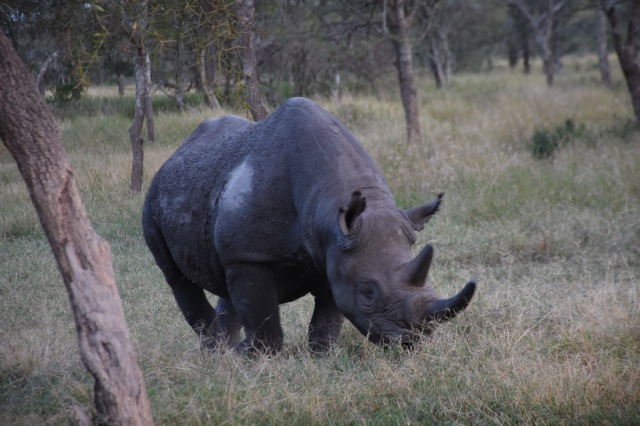We packed up and left the Asnil Samburu camp early on Wednesday morning. We enjoyed our two days here but were ready to move on to our next destination, the Sweetwaters Serena camp in the Ol Pejeta Conservancy. Here we would have the opportunity to see both the Black and the less common White Rhinos.
Most of the parks we are visiting are a good 4 to 5 hour drive (some longer) over both paved and dirt roads. The distances are not that great, it’s just that the roads are in such poor condition that we have to take it slow. Even the paved roads are littered with potholes, requiring Mwok to swerve, sometimes into the oncoming lane, sometimes onto the dusty shoulder, to avoid them.

One of our two Land Rovers
Moving along the unpaved roads is a jarring experience. We bounce up and down in our seats, heads rolling side to side in unison, like well choreographed dancers. Our eyes fixed on the road ahead so as to brace ourselves for the big holes. Speeding along the relatively flat washboard sections, the vibration and loud rattle inside the Rover makes reading, sleeping or conversation impossible. We slide open our windows when we can to let fresh air into the cabin, but quickly shut them when passing vehicles engulf us in a cloud of dust. No passenger cars here. Just 4 wheel drives, trucks and occasional motor cycles. Despite the road conditions, no one is complaining. We came here for adventure and we’re getting it.
We pass many small towns along the way each looking pretty much the same. Small, square cinder block stores each one brightly painted a different color: Red, blue, turquoise, green and yellow with hand-painted signs, mostly in English. Women sit in front of small stands selling fruits and vegetables, and men stand in doorways in conversation with each other. Some are on bikes, some on motorcycles and some herding sheep or goats through town. The children see us coming and stand by the road side, waving and smiling, “Hello! Hello!” We smile and wave back.
There are 10 of us traveling in two, six passenger vehicles. By now we have gotten to know each other and are getting along quite well. There is Ruben and Esther from Spain, Merle from South Africa and Evan, her 12 year old son, both of whom now live in Los Angeles. Mari and Greg are from Sapporo, Japan and Jianing and Shuli from China. All except Shuli speak English well, but she is learning. We have bonded with “Johnny” and Shuli, and have found them to be most enjoyable traveling companions. When conditions in the Rover permit we share stories with our seasoned travelers.
Shortly before arriving at Sweetwaters we stopped and toured a Chimpanzee rescue center. Chimpanzees are not native to Kenya, preferring the rainforest habitat west of western Tanzania and Uganda. During the civil war in In 1994, the chimps were relocated here in cooperation with the Jane Goodall Foundation. Some end up here when their parents are killed by poachers, while others are rescued from cruel conditions while in captivity elsewhere.

One of the rescued chimps
The chimps are enclosed in high, electrified fences or surrounded by water moats (they cannot swim). The caretakers never enter the enclosures as these powerful primates can easily kill a human. In fact, there is a safety cage that the workers can escape to in case one should manage to get through the fence. The chimps have a good life here with 24 hour medical care, three meals a day and enclosed sleeping quarters. They will never, however, be released into the wild as they have lost all of their survival skills. This reserve is entirely supported by private funds, and Roz and I “adopted” one resident named Manno, for a small donation. Chimpanzees can contract all of the diseases common to man, as we share 98% of the same DNA making them our closest cousins. We spent about an hour with a ranger walking around the wire perimeter spending time watching the chimps who came close to the fence to study us.

One of the chimps checking us out
Soon after the chimp rescue center we entered the Sweetwaters camp, a spacious camp set alongside a well-used watering hole. As we walked to the reception area, we could see Impalas, Warthogs, Storks, Geese and a host of other birds feeding and lounging in the afternoon sun. Roz and I went to our own waterhole for a cold local beer. After a beautiful buffet lunch, we climbed into our Land Rovers for an afternoon game drive. On the Ol Pejeta reserve we spotted large bull elephants, Thompson Gazelles, Grey-crowned Cranes, but it wasn’t until late that afternoon that we spotted our first Rhino.


Wildebeests sparring

Roz feeding rescued Rhino which is protected at night by 4 armed guards.
There are three species of Rhinos in Africa, The Black Rhino is distinguished by its narrow lower jaw and prehensile (meaning able to grasp) mouth that allow it to feed on brush and trees. The slightly larger White Rhino and the Northern White Rhino have a large, squarish jaw that enables it to graze on grasses. White Rhinos are not, in fact, white. They are called so due to a corruption of the word “wide” by early settlers, referring to their wide jaws. Both primary species are found here in Ol Pejeta, but the White is far less common.

A Black Rhino
About 25 years ago there were more than 25,000 Rhinos roaming this savannah, but now there are only about 400 thanks to poachers. They have been killed solely for their horns to sell on the Asian market and are said to fetch a price equivalent to that of gold. It wasn’t until 2012 that the Kenyan government started to do something. Now its taken seriously enough that you see armed rangers scattered about the park with orders to shoot to kill. The recently conservation efforts, however, have been too late to save the Northern White Rhino species.
Earlier this year there only three Northern White Rhinos, two females and one male, in existence, all within this park. Sadly, a few months ago, the sole serving male named Sudan died (of natural causes), most certainly sealing the fate of this species. Efforts have been made with in-vitro fertilization and surrogates, but so far all have met with failure.
As dusk approached Mwok drove us to a corner of a fenced in section of the reserve. There we could see three white rhinos casually grazing on the dry grass. Cattle Egrets were feeding around them as the rhinos kicked up the insects disturbed by the rhinos shuffling feet. Here were the two last remaining Northern White Rhinos, along with another rhino to keep them company. They are well cared for and protected in this corner of the park. We took pictures and silently admired these magnificent animals, fortunate to have seen them before they are gone forever.

One of two last remaining Northern White Rhinos
Truly wonderful pictures and commentary – we feel like we’re right there with you!
LikeLike
Another awe inspiring adventure! So sad that more could not have been done to stop the poaching of these incredible animals…a shameful chapter in a very long history of large animal extinctions.
LikeLike